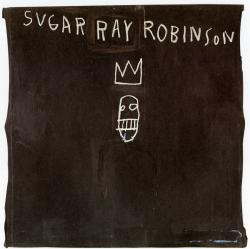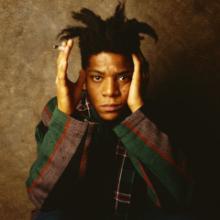CURATOR'S CHOICE SM
Exhibition Reviews
| Home | | Museum
Guide | | International |
| Theater |
Jean-Michel Basquiat is Back Home
By Adèle Bossard
The Gagosian Gallery's new exhibition is worth braving the winter winds around Chelsea Piers. It explores the work of the great New Yorker vanguard artist Jean-Michel Basquiat and takes place just next door to the Mary Boone Gallery, an annex of the gallery of the same name where he had his first solo show back in 1984.
Twenty-five years after his death, Jean-Michel Basquiat remains an icon of the explosive and decadent New York underground scene. Born and raised in Brooklyn, Basquiat is the son of a Haitian father and an Afro-Puerto-Rican mother. She took him to the greatest art museums in Manhattan and passed on to him her love for art. As a precocious child, he could speak three different languages at the age of eleven. Aged 15, he left the family home and took to the streets to graffiti in Lower Manhattan, using the name of SAMO. In 1981, he inscribed “SAMO is dead” on the walls of SoHo and began painting. The result is stunning. His style is original and unique, using painting, drawing, poetry, graffiti and collages on panels of diverse forms and materials. Through this variety of media, Basquiat expresses a spontaneous, vigorous and definitely avant-guardist talent.
At the crossroads of both Caribbean and Afro-American cultures, his art emerges from personal attachments and preoccupations, notably with references to black history. Along the way, you will see different paintings paying tribute to some major black figures: musicians like Charlie Parker and Miles Davis or boxers like Sugar Ray Robinson and Cassius Clay. The darker side of black history also exudes as a consequent part of the works exhibited, featuring dark skinned people – black, brown or red – with masklike faces and sometimes unchained. Concurrently, Basquiat provides scathing commentaries on the harsher realities of his time towards race, culture and society. He uses words “like brushstrokes” he says. He marries texts and images, abstraction and figuration in vivid colored sets.
A contemporary of Andy Warhol, who became one of his closest friends, Basquiat's work is undoubtedly anchored in the advent of a consumerism, a society where people are constantly hailed by words, ads, symbols. This is a feeling that exudes from most of the paintings on display. They represent human bodies on colorful backgrounds, surrounded by all sorts of words, brand names and copyright signs. With 59 works from both public and private collections, the Gagosian Gallery offers a wide range of selections from Basquiat's short but amazingly prolific career. While his popularity soared in the mid-1980s, so did his drug addiction. Gradually, drug abuse affected his mind. In the summer of 1988, he isolated himself in his Hawaiian studio to kick his heroin addiction and came back to New York, claiming to be sober. But ten days later, on August 12, 1988, he was found dead of an overdose in his NoHo art studio. Aged only 27 and with a career that barely lasted a decade, he left behind some 800 paintings and more than 1,500 drawings.
Adèle Bossard is a free lance writer from Saumur, France. |



